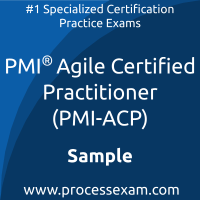 You have to pass the PMI-ACP exam to receive the certification from PMI. To increase the effectiveness of your study and make you familiar with the actual exam pattern, we have prepared this PMI Agile Practitioner sample questions. Our Sample PMI Agile Certified Practitioner Practice Exam will give you more insight about both the type and the difficulty level of the questions on the PMI Agile Practitioner exam.
You have to pass the PMI-ACP exam to receive the certification from PMI. To increase the effectiveness of your study and make you familiar with the actual exam pattern, we have prepared this PMI Agile Practitioner sample questions. Our Sample PMI Agile Certified Practitioner Practice Exam will give you more insight about both the type and the difficulty level of the questions on the PMI Agile Practitioner exam.
However, we are strongly recommending practice with our Premium PMI Agile Certified Practitioner (PMI-ACP) Practice Exam to achieve the best score in your actual PMI-ACP Exam. The premium practice exam questions are more comprehensive, exam oriented, scenario-based and exact match of PMI Agile Certified Practitioner exam questions.
PMI Agile Practitioner Sample Questions:
01. Why was Feature-Driven Development created?
a) To accommodate larger teams
b) To create features that are developed
c) To incorporate many stakeholders in the process
d) To complement Scrum
02. How can you tell when you have a user story that isn’t going to be effective?
a) It can be tested.
b) It is large enough to explain the work.
c) You can negotiate items in it.
d) It stands alone as an independent item.
03. What does the Agile Manifesto mean by “individuals and interactions over processes and tools”?
a) It means that processes and tools aren’t needed on Agile projects.
b) It means that without processes and tools, the individuals and interactions will not be effective.
c) It means that individuals and interactions are valued more than processes and tools.
d) It means that both are necessary and work together to produce working software.
04. It is important for the Agile team to be able to see the “Big Picture” in a visual way. Which of the following would be the best tool for prioritization?
a) Epic
b) User story
c) Wireframe
d) Story map
05. Your Agile team is working on the fifth iteration of their project, and the sponsor is reviewing their risk burn down chart. How will the sponsor know if risk is being managed on the project?
a) As the team mitigates or avoids risk, the chart should trend up.
b) As the team mitigates or avoids risk, the chart should trend down.
c) As the team mitigates or avoids risk, the chart should have less information.
d) As the team mitigates or avoids risk, the chart should be distributed to the sponsor.
06. Which of the following best describes a team’s velocity from the first iteration on?
a) Velocity is based on the decomposition of activities and their sequence.
b) Velocity varies in the first iterations, increases, and eventually plateaus.
c) Velocity is determined by the product owner.
d) Velocity is based on approved deliverables, milestones, scope, and resource management plans.
07. The planned value on your current project at this point in the schedule is $10,000, and the earned value is $9,600. What is the schedule variance?
a) $400.00
b) 0.96
c) –($400.00)
d) 1.04
08. Your customer is asking you to describe what you mean by self-organizing and self-managing teams. How would you describe them?
a) Your team is colocated, which helps with self-organization and self-management.
b) Your team is a group of experts who don’t need a manager.
c) Your team can make all project-related decisions.
d) Your team can make local decisions about how to produce the result of each iteration based on a shared knowledge of the definition of done.
09. A key stakeholder is asking what is the estimated time for the entire project to be completed. Which of the following will you show them to help answer that question?
a) Kanban board
b) Gantt chart
c) Burn down chart
d) Process flow diagram
10. What would be the reasoning behind having an Iteration Zero?
a) To determine a process that works
b) To prove that the product should be built
c) To prove that the product will be built correctly
d) To prove the process will work
Answers:
Question: 01
Answer: a |
Question: 02
Answer: b |
Question: 03
Answer: c |
Question: 04
Answer: d |
Question: 05
Answer: b |
Question: 06
Answer: b |
Question: 07
Answer: c |
Question: 08
Answer: d |
Question: 09
Answer: c |
Question: 10
Answer: a |
If you find any errors or typos in PMI Agile Certified Practitioner (PMI-ACP) sample question-answers or online PMI Agile Practitioner practice exam, please report them to us on feedback@processexam.com
 You have to pass the PMI-ACP exam to receive the certification from PMI. To increase the effectiveness of your study and make you familiar with the actual exam pattern, we have prepared this PMI Agile Practitioner sample questions. Our Sample PMI Agile Certified Practitioner Practice Exam will give you more insight about both the type and the difficulty level of the questions on the PMI Agile Practitioner exam.
You have to pass the PMI-ACP exam to receive the certification from PMI. To increase the effectiveness of your study and make you familiar with the actual exam pattern, we have prepared this PMI Agile Practitioner sample questions. Our Sample PMI Agile Certified Practitioner Practice Exam will give you more insight about both the type and the difficulty level of the questions on the PMI Agile Practitioner exam.